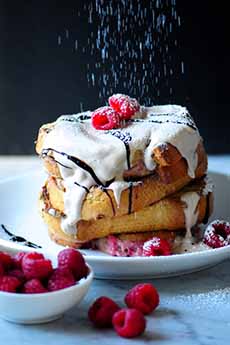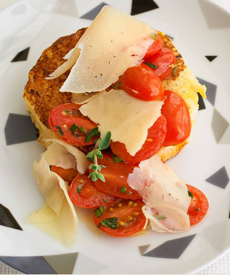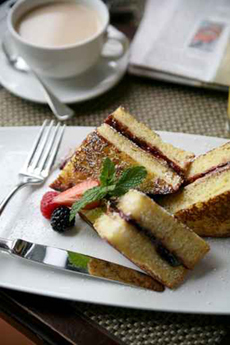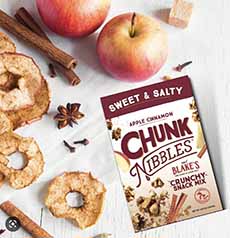|

[1] Raspberry-Mascarpone-Stuffed French Toast with Balsamic Glaze (photo © DeLallo).

[2] French Toast banana split (photo © Tillamook County Dairy Association).

[3] Savory French Toast with cherry tomatoes and Parmesan cheese (photo © Castello Cheese).

[4] Monte Cristo, a French Toast sandwich.

[5] Croissant French Toast with cherries and chocolate (photo © California Cherries).
|
|
November 28th is National French Toast Day, and we have both sweet and savory French Toast recipes for you. First, a bit of history, then 30 great recipes.
Elsewhere on The Nibble:
> The history of bread.
> The different types of bread: a photo glossary.
> The year’s 116 breakfast holidays.
FRENCH TOAST HISTORY
The dish known in America as French toast has roots at least as far back as ancient Rome, where it was a sweet dish.
In fact, pain perdu (or lost bread), the current French name for the dish, was once called pain à la romaine, or Roman bread.
While the story evolved that French toast was a food of the poor trying to scrape together a meal from stale bread, recipes from ancient and medieval times were food for wealthy people. Recipes used white bread, a luxury, with the crusts cut off.
Poor people ate brown bread, which was cheaper because the wheat endosperm did not have to be milled and sifted through screens to create white flour.
Costly ingredients such as spices (cinnamon, cloves, mace, nutmeg, and sugar), and almond milk are found in numerous recipes. The cooked bread was topped with costly honey or sugar.
And cookbooks themselves were the province of the wealthy: Only wealthy people and clergy learned to read.
In addition to savory French toast recipes for breakfast, lunch, or dinner, more recently, French toast has evolved into a savory sandwich, the Monte Cristo.
It’s an evolution of the Croque-Monsieur, a crustless sandwich of ham and Gruyère cheese, buttered and lightly browned on both sides in a skillet or under a broiler.
The Croque-Monsieur was invented in Paris in 1910. A variation with a baked egg on top is a croque-madame. Neither sandwich was battered, like French toast.
The Monte Cristo sandwich was invented in the Coronado Hotel in San Diego, according to the L.A. Times. The first recipe in print is in the Brown Derby Cookbook, published in 1949. It’s a triple-decker sandwich, battered and pan-fried.
Here’s a Monte Cristo recipe.
30+ FRENCH TOAST RECIPES
Sweet French Toast
Sweet French Toast recipes can be served for breakfast, brunch, and dessert.
Apple Pecan French Toast
Baked Cinnamon Swirl French Toast
Banana Split French Toast
Bananas Foster Grilled Cheese On French Toast
Banana-Stuffed French Toast With Chocolate
Blackberry Grand Marnier Baked French Toast
Brioche French Toast Recipe With Dulce De Leche
Cream Cheese Stuffed Baked French Toast
Create Your Signature French Toast
Eggnog French Toast
Eggnog French Toast Christmas Tree
French Toast Nuggets
French Toast Sandwiches
French Toast With Sautéed Apples
Grand Marnier French Toast
Havarti-Stuffed French Toast With Blueberries
Irish Soda Bread French Toast
Pandoro Star French Toast
Panettone French Toast
Panettone French Toast With Nutella & Jam
Pumpkin-Apple French Toast
Pumpkin Liqueur French Toast
Pumpkin Swirl Bread French Toast
Raspberry Mascarpone Stuffed French Toast With Balsamic Glaze
Savory French Toast
Savory French Toast recipes can be served for breakfast, brunch, lunch, and dinner.
Blue cheese and sliced apples
Cherry Tomatoes & Parmesan
Feta & Kalamata Olives With Dill Or Oregano
Foie Gras With Brioche French Toast
French Toast Sandwiches
Monte Cristo Sandwich
Savory French Toast With Heirloom Tomato Salad
Smoked Salmon, Caviar, & Crème Fraîche
|

















